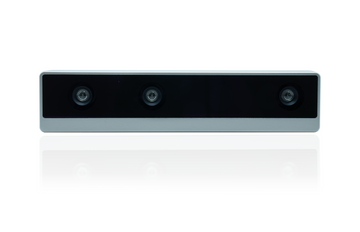OAK-D LR

Stereo
Looking for more details? Visit specific features at Platform -> Features
RVC2 inside
- 4 TOPS of processing power (1.4 TOPS for AI) - RVC2 NN Performance
- Run any AI model, even custom-architectured/built ones - models need to be converted.
- Encoding: H.264, H.265, MJPEG - 4K/30FPS, 1080P/60FPS
- Computer vision: warp/dewarp, resize, crop via ImageManip node, edge detection, feature tracking. You can also run custom CV functions
- Stereo depth perception with filtering, post-processing, RGB-depth alignment, and high configurability
- Object tracking: 2D and 3D tracking with ObjectTracker node
- On-device programming: Run custom logic/tasks on-device (guide)
Power consumption
- Base consumption + camera streaming: 2.5W - 3W
- AI subsystem consumption: Up to 1W
- Stereo depth pipeline subsystem: Up to 0.5W
- Video Encoder subsystem: Up to 0.5W
IMU
Operating temperature
Theoretical depth accuracy
| HFOV [°] | < 2% depth error | < 4% depth error | < 8% depth error | MinZ |
|---|---|---|---|---|
| 10 | 54.9 m | 137.2 m | 274.3 m | 1.92 m |
| 20 | 27.2 m | 68.1 m | 136.1 m | 95 cm |
| 30 | 17.9 m | 44.8 m | 89.6 m | 63 cm |
| 40 | 13.2 m | 33.0 m | 65.9 m | 46 cm |
| 50 | 10.3 m | 25.7 m | 51.5 m | 36 cm |
| 60 | 8.3 m | 20.8 m | 41.6 m | 29 cm |
| 70 | 6.9 m | 17.1 m | 34.3 m | 24 cm |
| 80 | 5.7 m | 14.3 m | 28.6 m | 21 cm |
| 82 | 5.5 m | 13.8 m | 27.6 m | 20 cm |
| 90 | 4.8 m | 12.0 m | 24.0 m | 17 cm |
| 100 | 4.0 m | 10.1 m | 20.1 m | 14 cm |
< 2% error- 20th disparity pixel, which has 5% full-pixel error (~2% with subpixel enabled)< 4% error- 8th disparity pixel, which has 12.5% full-pixel error (~4% with subpixel enabled)< 8% error- 4th disparity pixel, which has 25% full-pixel error (~10% with subpixel enabled)
Tested lenses
Lens kit 1 link
| Lens model | SKU | Fits into enclosure* | HFOV | Measured HFOV | Notes |
|---|---|---|---|---|---|
| M25170H12 | LN007 | 2 mm | 180° | 180° | |
| M27195H15 | LN055 | 2 mm | 150° | 150° | |
| M27210H08 | LN005 | yes | 125° | 130° | Some vignetting |
| M27280M07S | LN013 | / | 90° | / | |
| M25360H06S | LN012 | yes | 80° | 80° | |
| M2504ZH05S | LN011 | <1 mm | 70° | 73° | |
| M2506ZH04 | LN003 | 3 mm | 55° | 55° | |
| M2508ZH02 | LN002 | 2.5 mm | 40° | 42° | |
| M2512ZH03 | LN065 | 3 mm | 25° | 25° | |
| M2516ZH01 | LN001 | image not sharp | 20° | / |
*some lenses fit in the device, but the front enclosure doesn't close completely, which leads to degraded IP rating
Lens Kit 2 link
| Lens model | SKU | Fits into enclosure* | HFOV | Measured HFOV |
|---|---|---|---|---|
| M25156H18 | LN031 | Maye ok | 180° | 180° |
| M23272M14 | LN056 | 1 mm | 140° | 125° |
| M23356H09 | LN033 | 2 mm | 90° | 80° |
| M23390H08 | LN053 | Maybe ok | 70° | 72° |
| M2306ZM13 | LN024 | 2 mm | 50° | 50° |
| M2025ZM02 | LN036 | 9 mm | 20° | ~13° |
*some lenses fit in the device, but the front enclosure doesn't close completely, which leads to degraded IP rating
Lens Kit 3 link
| Lens model | Fits into enclosure | HFOV | Measured HFOV | Notes |
|---|---|---|---|---|
| M40180H10 | yes | 100° | 145° | Some vignetting |